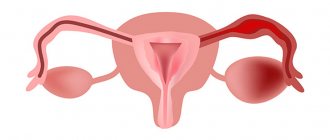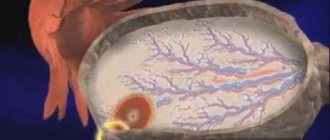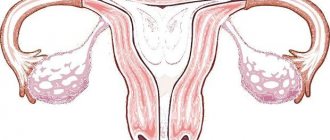What diseases can cause cervical discomfort?
Cervical pain can be a symptom of inflammation and various precancerous diseases.
The following diseases are detected as causes of pain:
- Pseudo-erosion (ectopia) – this pathology is characterized by an abnormal position of the epithelium outside the canal cavity. The leading symptom is moderate pain in the cervical area. There is some slight bleeding.
- Erosion - the basis of this disease is the appearance of a defect in the multilayered epithelium (a scratch or a small wound). If the reparative processes proceed normally, and there are no foci of inflammation, then the wound heals. If pathogenic flora or disruption of the regeneration process is present, then healing does not occur.
- Leukoplakia - the formation is located on the cervix and consists of pale areas of keratinization. The process is a consequence of previous infections. The formation easily transforms into malignant.
- Ectropion is an eversion of the mucous membrane of the canal. The cause of formation is injury to the mucous membrane during abortion or curettage.
- Erythroplakia - the formation looks like a red spot located on the mucosa. The reasons for this process have not yet been established.
Pain in the cervix occurs not only when it is directly affected. They are present when the body of the uterus is damaged.
Cervical pain occurs with the following pathologies of the uterine body:
- endometrial cancer – with it, pain begins in the later stages;
- inflammatory diseases of the uterus;
- hypertension during pregnancy caused by progesterone deficiency;
- leiomyoma is a benign tumor originating from the endometrium;
- adenomatosis - considered a precancerous condition, uncontrolled growth of cells in the mucous layer occurs due to the high content of female sex hormones;
- stenosis - a sharp narrowing of the cervical canal, there is congenital and acquired (infections, tumors, consequences of operations and diagnostic procedures);
- endometriosis (adenomyosis) – pathology is characterized by uncontrolled growth of cells of the mucous layer beyond its boundaries;
- prolapse and prolapse - disruption of the position of the uterus due to weakening of its ligaments and muscles of the pelvic floor;
- lack of female sex hormones, which is characterized by pain in the lower abdomen during menstruation;
- polyps are benign tumors localized in the cervix and its mucous layer;
- endometrial hyperplasia - proliferation of the glandular or basal layer.
All these diseases of the body and cervix cause pain. Differentiate using ultrasound, gynecological examination and laboratory tests.
Hormonal disbalance
Pain in the uterus can occur as a result of strong tone. The cause is hormonal imbalance - lack of progesterone.
Progesterone produced during the postovulatory period “signals” the uterus about its readiness to receive a fertilized egg. If it is deficient, a woman is unable to bear a child.
Against the background of a chronic lack of progesterone, the organ may be in constant tone, which is accompanied by a feeling of pain. Increased tone can occur as a result of the following diseases:
- Hyperandrogenism. With this diagnosis, the female body produces an excess amount of the male hormone - testosterone. The pathology manifests itself as menstrual irregularities, increased hair growth, and severe pain during menstrual bleeding. But testosterone may not be the only reason. Often, a woman’s adrenal glands are also involved in the formation of hyperandrogenism. When analyzing blood, an increase in such metabolites of male sex hormones as 17-OH-progesterone and DHEA sulfate is noted.
- Underdevelopment of the uterus. The problem can be either congenital or acquired. In the latter case, disorders develop during puberty.
- Active production of prolactin. The hormone prepares the uterus for a potential pregnancy. An increased level of prolactin in the blood causes it to tone, which leads to the development of pain. A sign of its excess is the release of colostrum from the breasts of a non-pregnant woman, as well as anovulatory cycles leading to infertility.
Pain due to benign tumors of the cervix or uterine body
Pain in the cervix can be a manifestation of benign tumors - polyps and fibroids.
Polyps
The intensity of pain with polyps ranges from mild to intense. Women also note discomfort and feel that there is something in the cervix.
Unpleasant sensations in the cervix intensify with physical impact on it (gynecological examination, sexual intercourse). Polyps are usually combined with other pathologies of the female genital area. Upon examination, the expansion of the canal is visible and a formation is detected in it. Palpation creates discomfort. An additional examination method is ultrasound.
Myoma
With fibroids, the pain is localized in the lower third of the abdomen and radiates to the cervical area. It enlarges and puts pressure on neighboring organs. Depending on the type of tumor, pain varies in intensity and location. Dull pain is typical and intensifies with changes in body position. Their intensity increases when urinating, and they haunt you at night. It hurts for a woman to sit. She feels that the pain is radiating or as if it is hitting her neck. A woman notes that her cervix hurts when she sits. Reports heaviness in the lower abdomen. If the fibroid is localized along the posterior wall, the pain radiates to the back or anal area. Sometimes it goes to my feet. During menstruation, the pain intensifies and has a cramping character. The phenomenon is explained by the fact that with this pathology the mucous layer is rejected worse and the uterus is forced to contract more strongly. Displacement of internal organs and disruption of their function is possible.
Vaginal dryness.
Vaginal dryness is associated with the hormone estrogen, or rather with its deficiency. (FYI: The problem isn't limited to postmenopausal women.)
“After all, estrogen itself is a growth hormone that improves blood flow to the vagina, vaginal wall thickness, and vaginal elasticity and lubrication,” says Dr. Anil. And when you don't have enough estrogen moving through your body—whether from birth control pills, breastfeeding, or, yes, menopause—it can make things pretty painful.
How to Treat Vaginal Dryness: If you feel like your vagina isn't lubricating as well as it used to, it might be time to consult your doctor. The doctor will be able to recommend a current method of combating dryness, perhaps even changing the method of contraception to make sex a little more comfortable for you.
Pain associated with pathologies of the uterus and appendages
Nagging pain in the projection of the ovaries, radiating to the cervix, is typical for inflammation of the appendages.
Examples of pathologies:
- adnexitis;
- salpingitis;
- salpingo-oophoritis.
The intensity of the pain syndrome can vary from mild pain in chronic processes to highly intense pain in acute conditions. A woman notes pain and discomfort during intercourse. Sitting down also hurts. There is a rise in body temperature to subfebrile levels. As the infection progresses, the pain has a jerking character. There are various discharges from the genital tract and other signs of infection. With an exacerbation of the process, general infectious symptoms may occur (nausea, dizziness, loose stools, vomiting). On examination, the entrance to the cervix is painful. Palpation of the ovarian area is painful on the left and right. Touching the neck causes pain.
Endometriosis
Endometriosis is somewhat of a confusing disease and it is also quite difficult for doctors to diagnose. Endometriosis is when uterine tissue grows outside the uterus (such as in the pelvis, abdomen, or even other places such as the lungs).
The condition is also incredibly painful. “This causes chronic inflammation and scarring around the tissue, which can cause pain,” says Dr. Anil.
How to treat: Endometriosis is usually treated with hormone therapy or surgery to remove any tissue causing pain.
Pain in precancerous conditions and cervical cancer
These diseases pose an increased danger to the life and health of women and require special attention during diagnosis, treatment and observation.
Erosion
The cervix may hurt due to erosion, but most often there is no discomfort with this pathology. First, pain appears in the lower third of the abdomen during menstruation and radiates to the lower back. Outside of menstruation, the uterus occasionally ache or there is a slight tingling sensation. The woman feels that she is pulling her neck.
Discomfort often appears after sexual intercourse (the cervix hurts from sex). The cervix may hurt due to any mechanical impact, for example, after an examination by a gynecologist. The examination is accompanied by bloody discharge. The appearance of pain during erosion indicates the addition of a bacterial infection.
Dysplasia
Dysplasia is considered a precancerous disease. The disease has an asymptomatic onset and stings a little during sexual intercourse. Constant pain appears only in the later stages or after infection has occurred. It begins to ache in the vagina. It hurts a woman if you touch her neck.
Cervical cancer
IMPORTANT! Cervical cancer occupies one of the first places in the structure of mortality among young women among all oncological pathologies.
In the initial stages, this disease does not manifest itself in any way. Then bleeding appears after sexual intercourse or a gynecological examination. There is a cutting pain in the neck area, radiating to the sacrum area. In later stages, pain appears in the neck, which can shoot down the leg. General weakness, fatigue, and weight loss are added. The formation can compress internal organs. Touching the cervix is extremely painful.
Inflammatory pathologies of the uterus and cervix
Inflammatory diseases of the neck and body are represented by cervicitis and endometritis.
Cervicitis
In pathology, the cervical canal and its vaginal part are affected. The woman notes that the cervix is enlarged and hurts.
The following symptoms are characteristic of this disease:
- the cervical canal hurts;
- nagging pain in the lower abdomen;
- feeling of discomfort during sexual intercourse;
- stabbing in the cervix;
- discharge from the genital tract.
During a gynecological examination, you can notice redness and swelling of the cervix in the area of the cervical canal. Its mucosa is covered with areas of pinpoint hemorrhages. The neck is compacted, pseudo-erosions are formed. Touching the neck is painful. When touched with a finger, blood vessels are easily damaged and the mucous membrane bleeds.
Endometritis
This pathology most often takes on a secondary nature; it is a continuation of the ascending inflammatory process in cervicitis. It develops as a complication of adnexitis (inflammation of the appendages) and salpingitis (inflammation of the fallopian tubes).
Endometritis manifests itself:
- nagging pain in the lower abdomen, radiating to the groin area;
- mucopurulent discharge from the genital tract;
- signs of general intoxication.
If the cervix shoots with endometritis, this indicates generalization of inflammation. The process can spread to fatty tissue. Inflammation of the uterus can become chronic. It can only manifest itself as painful periods. The cervix is compacted, swelling and redness are noted. If you press on it, it is sharply painful. A slight touch causes injury to the vessels on its surface and bleeding.
Prolapse and prolapse of the uterus
In the initial stages of the disease, the cervix bulges, pain radiates to the lower back. The pain is nagging and constantly bothers me. It intensifies with prolonged sitting. If the woman lies down, the pain subsides. She has a sensation of a foreign body in the vagina. You may feel heaviness in the lower abdomen. The woman begins to worry about constipation and frequent urination and pain.
Appendicitis
If the course of this disease is atypical or if it develops during menstruation, the symptoms may resemble pain during menstruation. A woman begins to mistakenly think that abdominal pain is menstrual in nature.
Its characteristic symptoms help identify the disease: pain begins near the navel, and after some time moves to the right lower abdomen. The discomfort intensifies when the hand is suddenly released after pressing on the stomach. There is a deterioration in general health, constipation, vomiting, the stomach becomes tense and hard, and later fever occurs.
Appendicitis is insidious due to the so-called period of imaginary well-being, when noticeable relief suddenly occurs. The woman thinks that the pain was caused by menstruation and went away on its own. In fact, the disease progresses at this time.
Periodic pain in the cervix during menstruation
Moderate pain in the cervix during menstruation is considered normal if it is not of high intensity and does not last long. They may appear if menstruation was preceded by heavy physical activity or sexual contact. This may be a pressing pain in the cervix. There may be pain in the cervix of a cramping nature, which intensifies with defecation.
The causes of painful periods are:
- increased pain sensitivity;
- lack of production of natural anti-pain substances (endorphins, enkephalins);
- endometriosis;
- violation of the position of the uterus;
- increased production of prostaglandins;
- uterine fibroids;
- corpus luteum phase disorder.
If you have painful periods, it is better to consult a gynecologist.
Injury
If “the lower back and lower abdomen hurt, what could it be in women”? You should see your doctor and he will determine, and if he finds nothing, you should think about traumatic incidents in your life that may have caused this pain.
“Have you disclosed your history of child abuse, sexual assault, or trauma from vaginal birth?” asks Dr. Simon. She explains that all of these non-obvious factors can cause vaginal pain.
If you have experienced sexual abuse or surgeries that have resulted in traumatic healing, disclosing this to your MD may help them recommend the right treatment - be it therapy, medications, etc. It is important for both doctors and patients to remember that mental health is as important a part of a health check as anything else.
Cervical pain and pregnancy
Pain in the cervix during short-term pregnancy indicates a possible pathology. In late pregnancy, if pain occurs for a short period, this is not a pathology. If this period is prolonged, you should contact an obstetrician-gynecologist. In any case, consulting a doctor will not do any harm and will help eliminate the possible latent course of severe pathologies.
The causes of pain during pregnancy are the following:
- isthmic-cervical insufficiency - weakening of the muscle ring in the area of the internal os of the uterus;
- cervical hypertonicity - increased uterine tone due to insufficient progesterone production;
- congenital underdevelopment of the uterus - the cells of the muscle layer cannot increase normally during pregnancy and respond with an increase in tone.
All these diseases lead to the fact that a woman cannot bear pregnancy. Pain is one of the signs of an impending miscarriage. If urgent measures are not taken, this will end in spontaneous abortion.
Your partner's penis.
If you experience unpleasant pain in your vagina after sex , you may be blaming your anatomy, but it may be your partner. "Is it really vaginal pain that you're experiencing, or is the pain during penetration something you feel inside your belly?" says Mary Jane Minkin, MD, OB/GYN, “It can be very hard to tell the difference.”
Essentially, this “lower abdominal pain” may actually be coming from the penis, which is penetrating you with discomfort (perhaps because it is too large for your vaginal anatomy). If sex makes you uncomfortable—and you suspect your partner's size is to blame—try changing positions, especially ones that don't allow for super-deep penetration, like reverse cowgirl. And be sure to use lube... lots of lube.
And if it's not the size, maybe it's your partner's. Do they have piercings? Do you have any piercings? Both can cause discomfort during sex. It's also important to consider the condoms you use, Dr. Simon adds. You may have a latex allergy, which can cause itching and pain in your vagina.
How to treat: Your family medicine doctor or gynecologist will be able to figure this out through an exam and an honest conversation with you. They may suggest changing condoms or trying lubricant.











